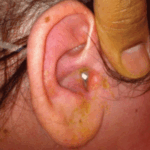Acute staphylococcal bacterial sinusitis is a severe form of sinus infection caused by Staphylococcus aureus. It results in inflammation of the paranasal sinuses, leading to pain, congestion, and possible complications if left untreated. This article explores its causes, symptoms, diagnosis, and treatment options.

Pathophysiology of Staphylococcus aureus Sinusitis
Staphylococcus aureus invades the sinus mucosa, triggering an immune response that leads to inflammation, mucus buildup, and obstruction of sinus drainage pathways. The infection may spread to adjacent structures, leading to complications such as orbital cellulitis or meningitis.
Causes and Risk Factors
Several factors predispose individuals to acute staphylococcal bacterial sinusitis:
- Previous Upper Respiratory Infections: Viral infections can weaken the mucosal barrier.
- Allergic Rhinitis: Chronic inflammation creates an environment for bacterial colonization.
- Nasal Polyps or Deviated Septum: Structural abnormalities impede sinus drainage.
- Weakened Immune System: Conditions such as diabetes and immunosuppressive therapies increase susceptibility.
- Recent Sinus Surgery: Postoperative infections are a common cause.
Symptoms
The hallmark symptoms of acute staphylococcal bacterial sinusitis include:
- Severe nasal congestion and obstruction
- Purulent nasal discharge (yellow-green mucus)
- Facial pain and pressure, particularly around the forehead, eyes, and cheeks
- Fever and malaise, indicating a systemic infection
- Headache and sinus tenderness
- Loss of smell (anosmia) in severe cases
Diagnosis
1. Clinical Examination
A thorough history and physical examination reveal characteristic symptoms such as sinus tenderness and purulent nasal discharge.
2. Imaging Studies
- CT Scan of the Sinuses: Detects sinus opacification, mucosal thickening, and obstruction.
- MRI (in severe cases): Identifies potential complications like orbital or intracranial spread.
3. Microbiological Testing
- Nasal swab culture to confirm the presence of Staphylococcus aureus
- Blood tests, including elevated white blood cell count and inflammatory markers
Treatment Options
1. Antibiotic Therapy
- First-line antibiotics: Amoxicillin-clavulanate, cephalosporins, or fluoroquinolones.
- Methicillin-resistant S. aureus (MRSA) cases: Vancomycin, clindamycin, or linezolid.
- Duration: 10–14 days, adjusted based on clinical response.
2. Symptomatic Management
- Nasal saline irrigation: Helps clear mucus and debris.
- Intranasal corticosteroids: Reduces inflammation and improves drainage.
- Pain relievers (NSAIDs): Alleviate sinus discomfort and fever.
3. Surgical Intervention
For refractory or recurrent cases, surgical options may be considered:
- Functional Endoscopic Sinus Surgery (FESS): Clears obstructions and improves sinus drainage.
- Drainage of Abscesses: Required if complications such as an orbital or intracranial abscess occur.
Prevention Strategies
- Hand Hygiene and Respiratory Protection: Reduces bacterial transmission.
- Allergy Management: Minimizes sinus inflammation.
- Proper Post-Surgical Care: Prevents secondary infections.
- Vaccination: Annual influenza and pneumococcal vaccines lower infection risk.
Potential Complications
If untreated, acute staphylococcal bacterial sinusitis may lead to:
- Orbital Cellulitis – Infection spreading to the eye socket.
- Meningitis – Bacterial invasion of the central nervous system.
- Osteomyelitis – Bone infection in the skull base.
Acute staphylococcal bacterial sinusitis is a serious condition requiring prompt medical attention. Early diagnosis and appropriate antibiotic therapy are crucial for preventing complications. Awareness of risk factors, symptoms, and treatment options can improve patient outcomes and reduce disease burden.

